The horrors of disaster. Personal tragedy. Continuing tokusatsu action for a new generation. The films in Hideaki Anno’s Shin Japan Heroes Universe explore all of these and more. But at each film’s heart, the Shin films are ultimately about the same theme: how people respond to tragedy.
There’s a little asterisk that needs to be put in here before going any further. This article is going to be discussing the Shin films. While the last installment of Neon Genesis Evangelion is also part of this collaborative project, to unpack that series may take more than one article, and it doesn’t sit quite as nicely among the reboots that have become its peers.
Shin Godzilla (2016)
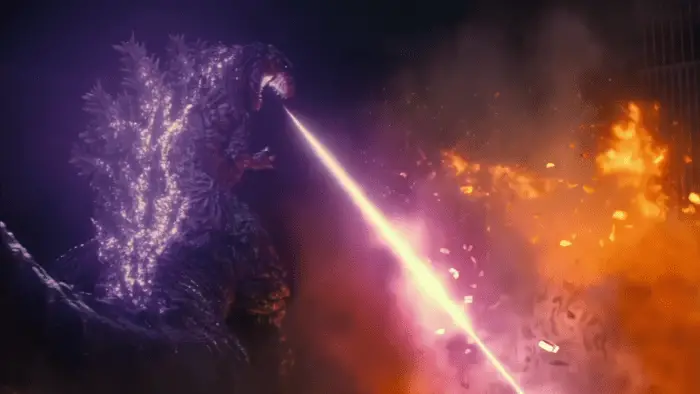
Shin Godzilla (2016, dir. Hideaki Anno, Shinji Higuchi) is easily the most well-known of this trilogy. With the greatest domestic and international gross out of any Shin movie, it goes to show that audiences aren’t tired of the radioactive beast.
Shin Godzilla is a film that, while it was released far before the onset of the 2019 pandemic, has taken on new meaning since. So much of it centers around following the layers of bureaucracy, expressed literally as the location of each office and boardroom is shown. Across multiple floors and even more meetings, the government is faced with one question: What can they do in the face of this disaster?
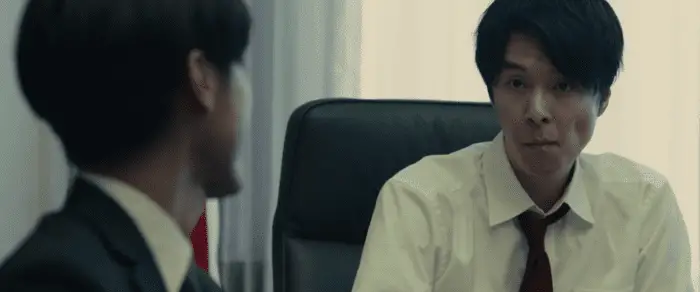
Rando Yaguchi (Hiroki Hasegawa) is perhaps the only person truly equipped to deal with it. He works his way directly through, and oftentimes against, the powers that be to actually get things done. Adorned with his red tie, he stands out, speaking his mind when he sees that lives are on the line. Far from another politician, Yaguchi wants solutions, not good press—you can’t become prime minister without a country, after all.
While the original Godzilla was about the horrors of the atomic bombs, the Shin Japan Heroes Universe installment is centered on a very similar theme. The film practically screams out that it is about the 2011 tsunami and subsequent Fukushima nuclear disaster and the Japanese government response.
Godzilla itself is more monstrous here than in recent memory, eschewing the characterization of Legendary’s current series of films for something more akin to a force of nature. While the Showa-era googly eyes are (thankfully) back, they’re attached to a version of Godzilla more terrifying than ever before. Previous iterations often had some form of personality or intelligence, but this one seems to be almost confused and even pained by its existence.

Shin Godzilla shows time and again that the higher up in government a person is, the more confidently wrong they tend to be. It’s the people who propose the correct answers and facts who are initially laughed at until the evidence becomes too great to ignore. Brilliantly, even a press conference is held where the prime minister is in the middle of lying about the monster’s capabilities—before he is proven wrong immediately after saying it.
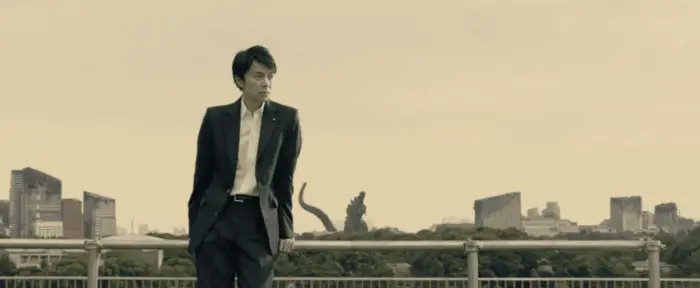
While many of the actual shots and scenes can come across as amateurish at times, the disaster imagery is so provocative that it can easily be excused. Shaky cell phone videos are a near-constant point of reference, as is the case in real-world disasters. When things change, and humanity fights back, these disaster elements take a different tone. Buildings stop collapsing as we know they do. Instead, they fall however they need to for their plans to work. It was oddly refreshing to see, these things don’t need to be realistic.
As the film progresses, and the layers of bureaucracy are stripped down, it becomes more inspirational than perhaps any other in the Godzilla franchise. Multiple nations work together towards a solution, giving everything they can including their trust. It would be easy to interpret the film as anti-government, or at least anti-Article 9. Shin Godzilla instead ends on thoughts of global collaboration towards an end goal, and that it’s not only possible but preferable.
Shin Ultraman (2022)

Shin Ultraman (2022, dir. Shinji Higuchi) is in an odd spot in this trilogy. Between only having Anno as a writer, and having its release delayed, a lot was going on behind the scenes. This film has an odd tone from Anno not co-directing, as well as writing it while wrapping up Evangelion.
Shin Ultraman immediately references the original series, including its title card fake out and using Gomess as its first kaiju. Initially, Gomess was a repurposed Godzilla suit, and here it’s immediately clear that it’s a reworked Shin Godzilla model. While the Shin Japan Heroes Universe films were already full of fun callbacks, these ones stick out.

If Shin Godzilla was all about finding hope in humanity, Shin Ultraman is about how that hope is not useless. So much of Ultraman centers around trust, almost entirely between individuals. Once again, it’s only through working together and trusting each other that the day is ultimately saved. From the moment Ultraman lands, there’s never a hopeless moment. There is always something worth believing in, from seemingly omnipotent alien saviors to even just each other and what we’re all capable of.
Shin Ultraman does so many things right in its visual effects that it’s difficult to find a spot to begin. While it lacked the huge budget that American films are known for, something which director Shinji Higuchi publicly lamented, it still managed to develop a visual style unique to this film. Ultraman flies around in a way distinctly alien, floating and spinning while holding a pose to the point that it becomes comical. But, it works. Even Ultraman’s beam was created using the same techniques used in 1966, giving it a unique style alongside modern CGI.
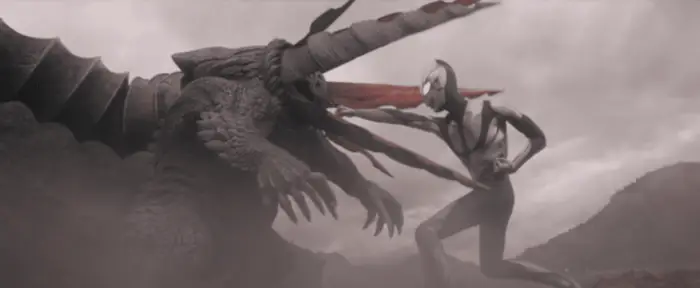
After spending so many years with Evangelion, Shin Ultraman feels healing, in a way. Both for Anno and his fans, it’s cathartic to have a story all about hope from the start, without those years of futility. In many ways, this is what the Shin Japan Heroes Universe is all about.
Every time Ultraman’s red lines fade to green, his energy depleted, he keeps fighting. That’s what it’s all about, isn’t it? Accepting the inevitability of death, but holding hope close, and living regardless of that?
Shin Kamen Rider (2023)

Shin Kamen Rider (2023, dir. Hideaki Anno) feels like the culmination of all these themes. It’s also quite possibly the best superhero film in recent memory. An incredible opening sequence settles audiences right in for two hours of slamming their action figures together, interrupted only so Anno can deliver the occasional gut punch.
The film is cheesy, it’s melodramatic, and the CGI can look like rubber. Yet, there is no worse use of a person’s time than trying to hate this movie. It’s time spent doing dangerous things with friends, smiles and laughs covering up any fear until long after it’s behind you.
More than the rest of this trilogy, Shin Kamen Rider feels put together. There’s a blend of real, slightly clunky, tokusatsu action that the other films lacked, as well as a more cohesive narrative direction. Character designs convey so much right away, and look incredible (Spider-Aug’s dreads invoke the appearance of spider legs, for instance).

Everybody acts differently, and their personalities are complementary. For all of its cheesy action, Kamen Rider never has those jarring moments that feel juvenile and out of place. No piece of characterization feels wasted or inappropriate, a reflection of how Anno’s style has matured since moving on from Evangelion.
Red scarf tied tight around his neck, Takeshi Hongo (Sosuke Ikematsu) is given power so great that it deforms him, his entire body taking on qualities of a grasshopper. While these changes are far from permanent, there’s real terror in him realizing what he’s become. A weapon, someone capable of punching clean through his fellow man. While he has a crisis over this fact, he’s reminded early on that he can use this power for good, to not be afraid of what he’s capable of.

Kamen Rider feels like a reminder that we’re not fighting alone, no matter who we lose. It’s not a crime to accept help, after all. Even the way SHOCKER brainwashes people, hiding every negative experiences behind euphoria, burying the pain so deep that it stops being a part of you.
That euphoria can’t last forever. When you do dangerous things with friends, that joy can’t stop them from getting hurt. It’s how you handle their loss that matters. It can consume you, lead you to hide away and want to alleviate all pain, or it can become a part of you, something that you carry forward, your father’s red scarf in your pocket.
“Heroes always wear red, right?”

For a series of reboots, for all of the references and callbacks, Anno’s Shin films don’t concern themselves with legacy. Not in any way that matters. They’re not intent on continuing these stories, but making new ones, reflections of the past in today’s mirrors.
Maybe this is why the ending of Shin Kamen Rider lands so well. There’s a new legacy being created, Rider #2 is here with the sun on his face and the wind at his back. It’s okay that Hongo stopped fighting, someone else is carrying on for him. He never had to suffer alone. While his entire body shook from the strain he was under, both external and internal, people were trying to help.
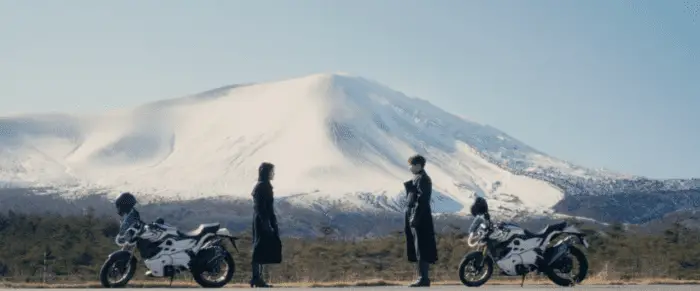
All of these films, at the end of the day, are about how people respond to tragedy. How they help each other, how they find hope, how they fight in every way they can. Anno writes about people who try to ignore it, who run from it, or who let it consume them, but something will always give.
The only thing we can do is to carry it with us, to do what we can in the sheer face of adversity. Helping each other, helping ourselves, and letting hope win. This is how humanity is meant to respond, tying a red scarf around our necks as we fight back to do what we feel is right.
“It’s in your hands, now.”


![[L to R] Nicole Damiani and Gianmarco Saurino as Lucia and Nicola in The Hottest Summer (2023). Amazon Studios 2023.](https://filmobsessive.com/wp-content/uploads/2023/08/DSC_2033-MOD-200x143.jpg)

